How To Find North On A Map
N References for Navigating with Map, Compass and GPS
To use a compass with your map and your GPS you need to have an understanding of the north reference used past each of them. In that location are 3 different norths in common use and in some cases choices to be fabricated about which to use on your compass, map and GPS.
The three options for northward
Truthful North

The True North Pole is the axis of the earth'southward rotation. The North Star is used as a true north reference. It'south position in the sky causes information technology to appear almost stationary with the other stars rotating effectually information technology. Lines or meridians of longitude tin can as well exist used as true north reference lines. Meridians of longitude converge at the True North and South Poles. The vertical edges of many maps are defined by a meridian of longitude, and can be used as a true north reference.
Magnetic North

The magnetic poles are aligned with the earth'southward magnetic field. A free floating magnetic needle in a compass will align itself with the magnetic field and thus points to the magnetic poles. Declination is the athwart difference between truthful north and magnetic north for a given location. The Magnetic Pole may appear to be either east or west of the True N Pole. Declination changes depending on your position relative to the two poles. Declination too changes over fourth dimension, because the location of the magnetic poles changes with time. Well-nigh GPS receivers volition calculate the declination for their current position. This is often referred to every bit "automated" north reference.
Grid North

Grid north is useful because it allows you to use the UTM filigree lines on your map equally your north reference. Grid due north is typically within 2° east or west of true north and varies with your position inside a UTM zone. When minimal accuracy is all that is required, it is common to treat grid north lines every bit truthful northward lines without accounting for the small difference.
Declination Diagram

About newspaper maps use a printed declination diagram to prove the relative direction of the three n references. Typically in that location will be an arrow that point to the top of the map and is parallel to the edges of the map. This is the "elevation of the map" northward reference that was used when the map was been printed. Commonly it volition be either True North (sometimes designated with a star, ot the letters TN) or Grid Northward (oftentimes designated with the letters GN). The angles between the three north references volition exist printed on the diagram.
The diagram should also take a date that the angle between True North and Magnetic North was determined. This declination bending changes over time. You should use a electric current value, non a many years old value printed on an old map. A source for the electric current declination at a given location is the National Geophysical Data Center's declination calculator. Your GPS can also calculate the declination for your electric current location.
Some maps have only a Due north Pointer, which may or may not bespeak which due north it is referencing. In some cases north on the map may not be at the top of the sheet. To use these maps with your compass and GPS, you will need to seek boosted clues as to the n reference. You volition also need to use a declination calculator to determine the electric current declination angle.
Customized North Reference Sheet
I've recently added a new folio that allows you to lookup the current declination for your location, and input the north reference choices you have made for your map and compass. The folio volition create a customized reference card for your specific state of affairs. Alter the settings and the diagram will change as well. It'southward a corking mode to play with various north reference choices and to learn who they bear upon the work y'all do in the field.
Design your ain declination reference sail.
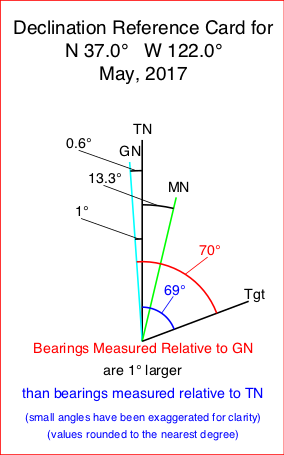
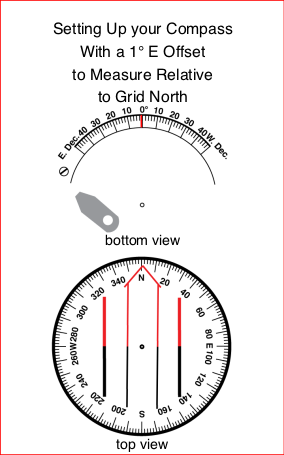
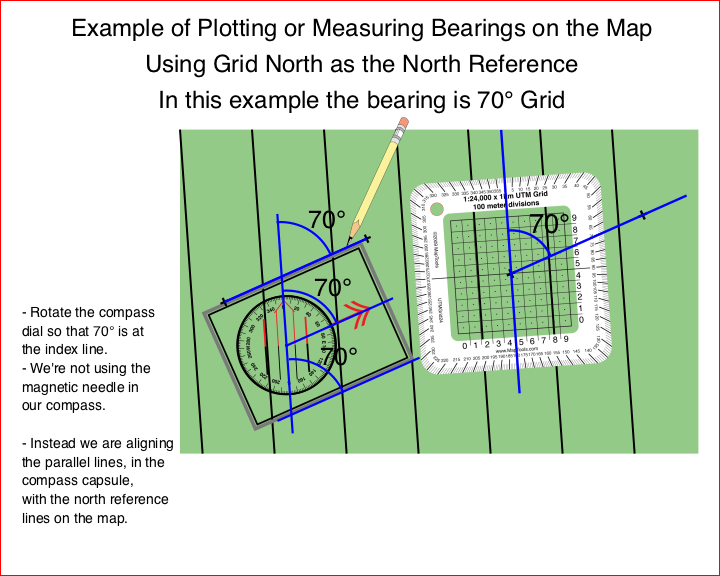

Choosing a North Reference, for your Map, your Compass, and your GPS
You may take choices to make between n references on your map and your compass. Your GPS can be set to use any of the three common references. When the north references are unlike betwixt your map, compass, and GPS, y'all will need to do conversions as you move bearings betwixt them.
North Reference on your Map
Grid North
Grid North is easy to utilize on maps with printed UTM / MGRS / USNG grid lines.
- Lots of north reference lines already printed on the map.
- Likely to be very close to Truthful North.
- When the level of accuracy required is low, Filigree North lines are often used as True North lines.
True North
Lines of Longitude are True North lines. Frequently the two vertical edges of the map are lines of longitude and tin can exist used equally Truthful Due north reference lines. They may be the only 2 Truthful Northward lines on you map, unless your map has a lat/lon grid printed on information technology.
Magnetic North
Many aviation and marine charts have pre-printed Magnetic North lines. Most other maps do not. You lot tin can draw parallel lines aligned with Magnetic North onto your map for use as north reference lines.
North Reference on your Compass
Magnetic North
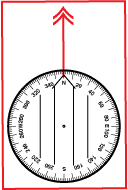
The needle or bill of fare of your compass will always align itself with Magnetic N. Thus Magnetic Northward is an easy and natural choice to apply with your compass
A compass that has not been adjusted to a dissimilar north reference, will read aught degrees when it is aligned with Magnetic North. All bearings taken with this compass should be referred to as "magnetic bearings." Since the compass is a magnetic device this is an intuitive upshot. It is also the result provided by compasses that cannot be adjusted. To plot a magnetic begetting onto your map you will likely need to convert the begetting to either a True or Grid Due north reference by adding or subtracting the declination for your current location. There is no demand to modify the aligning based on your location.
On a compass that reads relative to Magnetic north, the orientation arrow on the baseplate volition align with the 0° or North mark on the dial, equally is shown to the right.
Adjusting the North Reference on Your Compass to True or Grid Northward
Many compasses allow you to adjust the position of the lines used to marshal the magnetic needle with respect to the angle measuring dial. The aligning mechanism is typically either a gear driven ane with a small slotted screw and a small contumely screwdriver on the lanyard, or a elementary friction fit between the sheathing and the dial. The choice to adjust the north reference on your compass volition bear upon how you work with your compass and should be considered carefully.
Regardless of your decision on whether to accommodate the north reference or not, you must occasionally bank check to see that the compass is set as you lot wait it to exist. This is particularly true for the friction fit mechanisms which may loosen with time and adjust themselves.
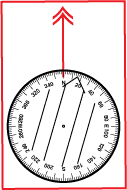
A compass that is adjusted will resemble the declination diagram. The orienting pointer and the parallel lines in the lesser of the capsule will exist aligned with Magnetic North, not the 0° or N marker on the dial. The aught degree marking on the dial is aligned with either True or Filigree North. All bearings taken with this compass should be referred to equally either "true bearings" or "grid bearings" depending on the northward reference you have adapted to. You will probable not demand to add or decrease conversion values to plot the bearing onto your map. You will need to call back to alter the adjustment to friction match your current location.
When the orientation arrow tin can non be adapted independently from the athwart dial, you lot can use some other mark to align the compass needle as pictured below. Some compasses have a printed scale for this purpose.
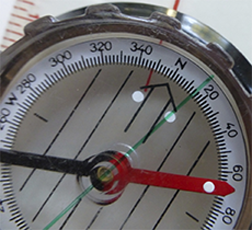
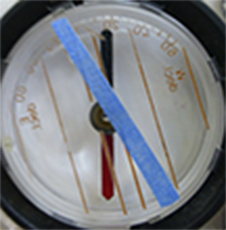
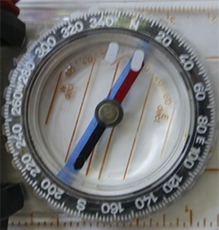
Card fashion compasses and sighting compasses generally tin can not be adjusted, and will ever provide bearings relative to Magnetic North. This is because the card and magnet are fixed to each other and sealed inside of the capsule.
A common problem for beginners occurs when someone adjusts their compass for them, and so they forget what was done and why. An incorrectly adjusted compass is useless for anything beyond a general sense of direction and may exist worse than no compass at all.
Two Schools of Thought
Set your compass and forget it Conform for the declination in your compass.
- All bearings volition be Filigree or True.
- No conversion required to use it on a map.
- Don't forget to check the setting occasionally.
- Don't forget to change information technology when you get somewhere else.
Fix your compass to 0°, and always think almost it
- All bearings will be Magnetic.
- Conversion to Grid or Truthful, or drawing Magnetic N reference lines on your map, will be necessary for map work.
- Works with all compasses.
- You are more than likely to remember how declination works.
- If your compass is adjustable, don't forget to check the setting occasionally.
North Reference on your GPS
You lot GPS can be fix to use any of the three northward references. The north reference choice is unremarkably located in the setup page for Heading or North Reference. Some GPS receivers use the name "Automatic" to bespeak that the GPS should summate the declination for the current location and brandish directional information relative to Magnetic North. There is oftentimes a selection that allows the user to enter a declination value to be used. This is probably not what yous desire. Make certain you lot empathise why you are using a user divers declination if y'all choose to do so.
Converting Between N References
The key to converting between the three north references is to add together a line representing the bearing to an imaginary target to the declination diagram. Now it is easy to see the dissimilar angles measured to the target from each of the north references. Remember the bending is measured from the desired northward reference line to the target begetting line. The measured angle'due south zero degree value is associated with the north reference line and increases in a clockwise direction.
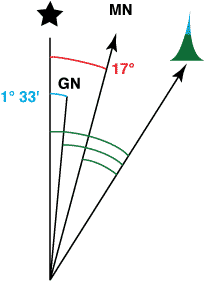
In the case at the correct, both Magnetic and Grid Northward are e of True North. A true bearing would exist 17° larger than a magnetic bearing. Thus to convert from a magnetic bearing to a true bearing you would add together 17°.
The bending measured from the target to Grid North is also larger than the angle measured from the target to Magnetic Due north. The difference is the 17° angle from Truthful Due north to Magnetic Due north less the 1° 33' bending from True Due north to Filigree North. Thus to convert from a magnetic bearing to a Grid N reference you would add fifteen° 27'. (I would likely round this to 15 i/2°. I might fifty-fifty circular to 15° if accurateness was not critical.)
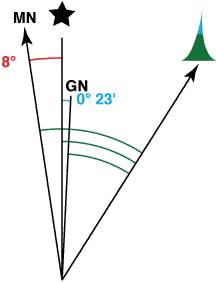
In the case at the right, both Magnetic North is west of True Northward and Grid North is east of True North. A true bearing would exist eight° smaller than a magnetic bearing. Thus to convert from a magnetic bearing to a true bearing you would subtract 8°.
The angle measured from the target to Grid North is also smaller than the angle measured from the target to Magnetic North. The difference is the eight° bending from Truthful Northward to Magnetic North plus the 0° 23' angle from True North to Grid Due north. Thus to convert from a magnetic begetting to a Grid N reference you lot would decrease eight° 23'. (I would likely circular this to eight i/2°or only viii°.)
Common Scenarios
Map=Grid, Compass=Magazine, GPS=Mag
- Easy to use reference lines already on the map.
- No compass adjustment needed.
- Conversion between Grid and Magnetic is required to work with compass bearings on the map.
Map=Grid, Compass=Grid, GPS=Grid
- Easy to utilise reference lines already on the map.
- Compass adjusted to Grid North.
- Adjustment should exist checked for correctness
- No conversions required to work with compass bearings on the map.
Map=Mag, Compass=Mag, GPS=Mag
- You volition need to draw reference lines on your maps.
- No compass adjustment needed.
- No conversions required to work with compass bearings on the map.
- You only need to worry about north reference at habitation when you depict the lines on your maps.
An All likewise Common Scenario
All too oftentimes I when encounter someone who is having trouble working with their map and compass they tell me, "Someone else set my compass up for me." I ask some question...
- Is it set up for true, grid, or magnetic bearings? I don't remember.
- Is is set for the declination here, or somewhere else? I don't know.
- Have you checked that information technology is set correctly? I don't know how to check it, or how to conform it.
What Practise I Use
My maps are gridded for UTM coordinates. So I use Grid North on the map. I utilise a sighting compass that con non be adjusted. So I use Magnetic Due north on my compass. When I move a bearing between my compass and my map, I convert the due north reference. My GPS is fix to automatically summate the declination and give directions relative to Magnetic North. When I goto a waypoint on the GPS, the bearing to the waypoint is magnetic. I can grab my compass, plow to face the bearing and be facing the target. Yep my GPS has a compass in it, and I could use it to face up the target besides. But without whatever sighting machinery, but using the arrow on the screen is not particularly authentic.
No bearing or heading is complete without the word
True, Magnetic, or Grid following it.
Don't make people gauge, say information technology and write it!
2010 Due north American Magnetic Declination
Current decliantion maps and calculators tin can be found at the National Geophysical Data Middle'southward web site.
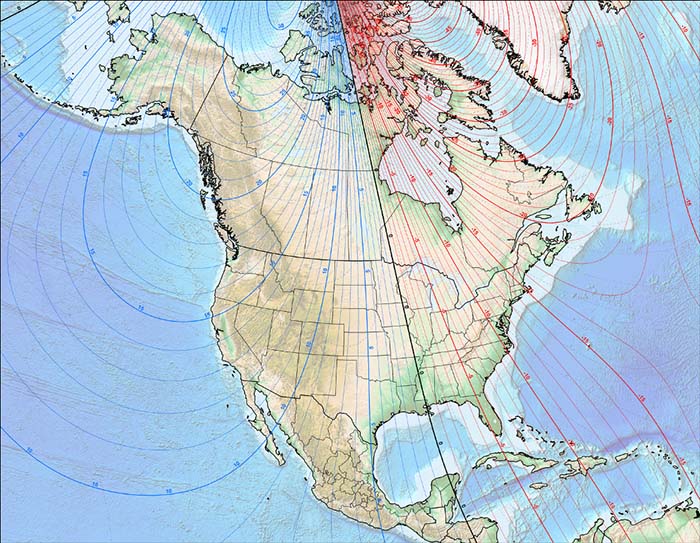
I have a iv page color handout on North references (single sheet folded in one-half) that I use in my navigation classes. I will send you lot one for free with you lot order if you wish. Or y'all can download the pdf file and take a look. If yous want to use the handout for your grade, you can order them for less than it would cost you to print them on your ain printer.
| Item description | Quantity | Price | Quantity |
| Due north Reference Sheet Part Id: NorthRefSheet, Fabricated in United states of america | 1 2+ | $0.00 $0.15 | |
How To Find North On A Map,
Source: https://www.maptools.com/north_reference
Posted by: kirbycathe1975.blogspot.com


0 Response to "How To Find North On A Map"
Post a Comment